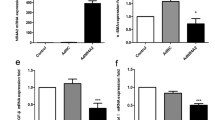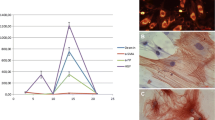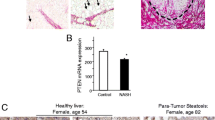Abstract
Background
Tension homology deleted on chromosome ten (PTEN) is important in liver fibrosis.
Aims
The purpose of this study was to evaluate the PTEN gene effects and mechanism of action on hepatic stellate cells (HSCs).
Methods
The rat primary HSCs and human LX-2 cells were transfected by an adenovirus containing cDNA constructs encoding the wild-type PTEN (Ad-PTEN), the PTEN mutant G129E gene (Ad-G129E) and RNA interference targeting the PTEN sequence PTEN short hairpin RNA (PTEN shRNA), to up-regulate and down-regulate PTEN expression, respectively. The HSCs were assayed with a fluorescent microscope, real time PCR, Western blot, MTT, flow cytometry and Terminal-deoxynucleoitidyl transferase mediated nick end labeling. In addition, the CCl4 induced rat hepatic fibrosis model was also established to check the in vivo effects of the recombinant adenovirus with various levels of PTEN expression.
Results
The data have shown that the over-expressed PTEN gene led to reduced HSCs activation and viability, caspase-3 activity and cell cycle arrest in the G0/G1 and G2/M phases, as well as negative regulation of the PI3K/Akt and FAK/ERK signaling pathways in vitro. The over-expressed PTEN gene improved liver function, inhibited proliferation and promoted apoptosis of HSCs both in vitro and in vivo.
Conclusions
These data have shown that gene therapy using the recombinant adenovirus encoding wild-type PTEN inhibits proliferation and induces apoptosis of HSCs, which is a potential treatment option for hepatic fibrosis.





Similar content being viewed by others
Abbreviations
- HSCs:
-
Hepatic stellate cells
- ECM:
-
Extracellular matrix
- α-SMA:
-
Alpha-smooth muscle actin
- PTEN:
-
Tension homology deleted on chromosome ten
- BDL:
-
Bile duct ligation
- shRNA:
-
Short hairpin RNA
- GFP:
-
Green fluorescent protein
- EGFP:
-
Enhanced green fluorescent protein
- H&E:
-
Hematoxylin and eosin
- MT:
-
Masson’s trichrome
- TUNEL:
-
Terminal-deoxynucleoitidyl transferase mediated nick end labeling
- FCM:
-
Flow cytometry
- FAK:
-
Focal adhesion kinase
- ERK:
-
Extracellular signal-regulated kinase
- PI3K:
-
Phosphoinositol-3-kinase
- Akt:
-
Serine–threonine protein kinase B
- ALT:
-
Alanine aminotransferase
- AST:
-
Aspartate aminotransferase
References
Hernandez-Gea V, Friedman SL. Pathogenesis of liver fibrosis. Annu Rev Pathol. 2011;6:425–456.
Friedman SL. Mechanisms of hepatic fibrogenesis. Gastroenterology. 2008;134:1655–1669.
Brenner DA, Kisseleva T, Scholten D, et al. Origin of myofibroblasts in liver fibrosis. Fibrogenesis Tissue Repair. 2012;5:S17.
Asahina K, Zhou B, Pu WT, Tsukamoto H. Septum transversum-derived mesothelium gives rise to hepatic stellate cells and perivascular mesenchymal cells in developing mouse liver. Hepatology. 2011;53:983–995.
Scholten D, Reichart D, Paik YH, et al. Migration of fibrocytes in fibrogenic liver injury. Am J Pathol. 2011;179:189–198.
Wasmuth HE, Weiskirchen R. Pathogenesis of liver fibrosis: modulation of stellate cells by chemokines. Z Gastroenterol. 2010;48:38–45.
Kisseleva T, Cong M, Paik Y, et al. Myofibroblasts revert to an inactive phenotype during regression of liver fibrosis. Proc Natl Acad Sci USA. 2012;109:9448–9453.
Liu X, Xu J, Brenner DA, Kisseleva T. Reversibility of liver fibrosis and inactivation of fibrogenic myofibroblasts. Curr Pathobiol Rep. 2013;1:209–214.
Kim HA, Kim KJ, Seo KH, Lee HK, Im SY. PTEN/MAPK pathways play a key role in platelet-activating factor-induced experimental pulmonary tumor metastasis. FEBS Lett. 2012;586:4296–4302.
Shi Y, Paluch BE, Wang X, Jiang X. PTEN at a glance. J Cell Sci. 2012;125:4687–4692.
Garcia-Junco-Clemente P, Golshani P. PTEN: a master regulator of neuronal structure, function, and plasticity. Commun Integr Biol. 2014;7:e28358.
Muniyan S, Ingersoll MA, Batra SK, Lin MF. Cellular prostatic acid phosphatase, a PTEN-functional homologue in prostate epithelia, functions as a prostate-specific tumor suppressor. Biochim Biophys Acta. 2014;1846:88–98.
White ES, Thannickal VJ, Carskadon SL, et al. Integrin α4β1 regulates migration across basement membranes by lung fibroblasts: a role for phosphatase and tensin homologue deleted on chromosome 10. Am J Respir Crit Care Med. 2003;168:436–442.
White ES, Atrasz RG, Hu B, et al. Negative regulation of myofibroblast differentiation by PTEN (phosphatase and tensin homolog deleted on chromosome 10). Am J Respir Crit Care Med. 2006;173:112–121.
Lan R, Geng H, Polichnowski AJ, et al. PTEN loss defines a TGF-β-induced tubule phenotype of failed differentiation and JNK signaling during renal fibrosis. Am J Physiol Renal Physiol. 2012;302:F1210–F1223.
Vinciguerra M, Veyrat-Durebex C, Moukil MA, Rubbia-Brandt L, Rohner-Jeanrenaud F, Foti M. PTEN down-regulation by unsaturated fatty acids triggers hepatic steatosis via an NF-κBp65/mTOR-dependent mechanism. Gastroenterology. 2008;134:268–280.
Hao LS, Zhang XL, An JY, et al. PTEN expression is down-regulated in liver tissues of rats with hepatic fibrosis induced by biliary stenosis. APMIS. 2009;117:681–691.
Zheng L, Chen X, Guo J, et al. Differential expression of PTEN in hepatic tissue and hepatic stellate cells during rat liver fibrosis and its reversal. Int J Mol Med. 2012;30:1424–1430.
Ma J, Li F, Liu L, et al. Raf kinase inhibitor protein inhibits cell proliferation but promotes cell migration in rat hepatic stellate cells. Liver Int. 2009;29:567–574.
Hao LS, Zhang XL, An JY, et al. Adenoviral transduction of PTEN induces apoptosis of cultured hepatic stellate cells. Chin Med J (Engl). 2009;122:2907–2911.
An J, Zheng L, Xie S, et al. Down-regulation of focal adhesion kinase by short hairpin RNA increased apoptosis of rat hepatic stellate cells. APMIS. 2011;119:319–329.
Knodell RG, Ishak KG, Black WC, et al. Formulation and application of a numerical scoring system for assessing histological activity in asymptomatic chronic hepatitis. Hepatology. 1981;1:431–435.
Wang Y, Gao J, Zhang D, et al. New insights into the antifibrotic effects of sorafenib on hepatic stellate cells and liver fibrosis. J Hepatol. 2010;53:132–144.
Singla DK. Akt-mTOR pathway inhibits apoptosis and fibrosis in doxorubicin-induced cardiotoxicity following embryonic stem cell transplantation. Cell Transplant. 2015;24:1031–1042.
Takashima M, Parsons CJ, Ikejima K, Watanabe S, White ES, Rippe RA. The tumor suppressor protein PTEN inhibits rat hepatic stellate cell activation. J Gastroenterol. 2009;44:847–855.
Povero D, Busletta C, Novo E, et al. Liver fibrosis: a dynamic and potentially reversible process. Histol Histopathol. 2010;25:1075–1091.
Che XH, Jiang WY, Parajuli DR, Zhao YZ, Lee SH, Sohn DH. Apoptotic effect of propyl gallate in activated rat hepatic stellate cells. Arch Pharm Res. 2012;35:2205–2210.
Li J, Li X, Xu W, et al. Antifibrotic effects of luteolin on hepatic stellate cells and liver fibrosis by targeting AKT/mTOR/p70S6 K and TGFβ/Smad signalling pathways. Liver Int. 2015;35:1222–1233.
Marin JJ, Hernandez A, Revuelta IE, et al. Mitochondrial genome depletion in human liver cells abolishes bile acid-induced apoptosis: role of the Akt/mTOR survival pathway and Bcl-2 family proteins. Free Radic Biol Med. 2013;61:218–228.
Van Duijn PW, Ziel-van der Made AC, van der Korput JA, Trapman J. PTEN-mediated G1 cell-cycle arrest in LNCaP prostate cancer cells is associated with altered expression of cell-cycle regulators. Prostate. 2010;70:135–146.
Paul-Samojedny M, Suchanek R, Borkowska P, et al. Knockdown of AKT3 (PKBγ) and PI3KCA suppresses cell viability and proliferation and induces the apoptosis of glioblastoma multiforme T98G cells. Biomed Res Int. 2014;2014:768181.
Aarts M, Linardopoulos S, Turner NC. Tumour selective targeting of cell cycle kinases for cancer treatment. Curr Opin Pharmacol. 2013;13:1–7.
Chung JH, Ostrowski MC, Romigh T, Minaguchi T, Waite KA, Eng C. The ERK1/2 pathway modulates nuclear PTEN-mediated cell cycle arrest by cyclin D1 transcriptional regulation. Hum Mol Genet. 2006;15:2553–2559.
Mitrea DM, Yoon MK, Ou L, Kriwacki RW. Disorder-function relationships for the cell cycle regulatory proteins p21 and p27. Biol Chem. 2012;393:259–274.
Brenner DA. Molecular pathogenesis of liver fibrosis. Trans Am Clin Climatol Assoc. 2009;120:361–368.
Wang J, Xu F, Zhu D, et al. Schistosoma japonicum soluble egg antigens facilitate hepatic stellate cell apoptosis by downregulating Akt expression and upregulating p53 and DR5 Expression. PLoS Negl Trop Dis. 2014;8:e3106.
Zhang S, Yu D. PI(3)king apart PTEN’s role in cancer. Clin Cancer Res. 2010;16:4325–4330.
Ming M, Han W, Maddox J, et al. UVB-induced ERK/AKT-dependent PTEN suppression promotes survival of epidermal keratinocytes. Oncogene. 2010;29:492–502.
Bunney TD, Katan M. Phosphoinositide signalling in cancer: beyond PI3K and PTEN. Nat Rev Cancer. 2010;10:342–352.
Dubrovska A, Kim S, Salamone RJ, et al. The role of PTEN/Akt/PI3K signaling in the maintenance and viability of prostate cancer stem-like cell populations. Proc Natl Acad Sci USA. 2009;106:268–273.
Lagares D, Kapoor M. Targeting focal adhesion kinase in fibrotic diseases. BioDrugs. 2013;27:15–23.
Podolska K, Stachurska A, Hajdukiewicz K, Malecki M. Gene therapy prospects-intranasal delivery of therapeutic genes. Adv Clin Exp Med. 2012;21:525–534.
Sakashita M, Mochizuki S, Sakurai K. Hepatocyte-targeting gene delivery using a lipoplex composed of galactose-modified aromatic lipid synthesized with click chemistry. Bioorg Med Chem. 2014;22:5212–5219.
Baertsch MA, Leber MF, Bossow S, et al. MicroRNA-mediated multi-tissue detargeting of oncolytic measles virus. Cancer Gene Ther. 2014;21:373–380.
Acknowledgments
This work was supported by the National Natural Science Foundation of China (Grant 30872513), Natural Science Foundation of Hebei Province (Grant C2010000565), and Hebei Provincial Science and Technology Department (Grant 09966108D). The authors would like to thank the foundations for their support. We appreciate Gregory X Shen for his valuable revision of written English and owe many thanks to Hong Zhang and Jinbo Guo for their photo contributions.
Author information
Authors and Affiliations
Corresponding author
Ethics declarations
Conflict of interest
The authors have declared no conflict of interest.
Additional information
Junyan An and Libo Zheng have contributed equally to this work.
Rights and permissions
About this article
Cite this article
An, J., Zheng, L., Xie, S. et al. Regulatory Effects and Mechanism of Adenovirus-Mediated PTEN Gene on Hepatic Stellate Cells. Dig Dis Sci 61, 1107–1120 (2016). https://doi.org/10.1007/s10620-015-3976-2
Received:
Accepted:
Published:
Issue Date:
DOI: https://doi.org/10.1007/s10620-015-3976-2




